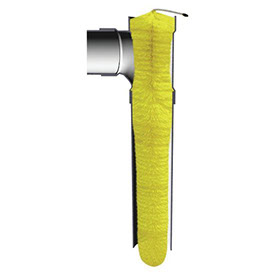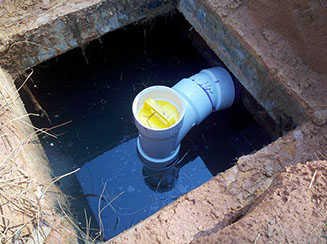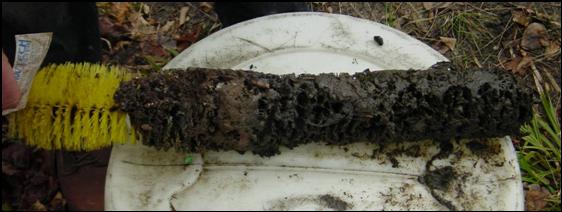How does a septic system fail?
- Jesse Todd

- Dec 13, 2019
- 4 min read
A septic system or component can fail for a number of reasons. Here are a few of the most common causes and simple ways to prevent your system from failing prematurely:
· Missing Outlet tee: This simple PVC tee is arguably the most crucial component to a septic system and protects the largest and most expensive component of the septic system. An outlet tee keeps organic matter (scum layer)that floats at the top of the septic tank from going into the Soil Treatment Area (STA or leach field). Even just a few weeks with a damaged or broken Outlet Tee can cause an STA failure. If you have a concrete tank there may be what is called a Baffle, which is simply a concrete wall that protects the outlet pipe from receiving the organic matter. The danger with a concrete baffle is that the concrete can deteriorate overtime leaving your STA vulnerable. Simply check once a year that your Outlet Tee or Baffle is not allowing scum to enter the outlet piping.

· Leaking toilet or faucet: A leaking faucet or toilet may not seem like a big deal, but it can quickly overload your septic system with more water than it was designed to handle. A typical septic system for a 3-5 bedroom home is designed to take between 350 to 675 gallons per day. A leaking faucet or toilet can release an additional 1000+ gallons of water in 24 hours. If the issue is not addressed quickly, it can cause your STA to fail prematurely within a matter of days or weeks.
· Roots: Roots are a common cause for piping or tank failure. This is why it is important to plant the right kind of vegetation around your system. If a tree or shrub is nearby, the roots can infiltrate the smallest gaps in the piping or work their way through the concrete of your septic tank. They can clog the lines that run from your house to your tank or from your tank to the STA and cause the septage to backup into your home. No one wants to deal with that! If you do have a root problem, you may want to consider removing the plant(s) that are causing the issues or apply root killer along your septic lines and around your tank.
See below, a recent tank that had to be replaced due to root infiltration.

· Compaction over an STA: 70% of compaction happens the first time you drive over an STA. Compaction over an STA can crush the piping or chambers that lie underground. STA’s work in two ways; they are designed so that the effluent water absorbs into the ground and also evapotranspirates into the air. If the soil above an STA is compacted, it limits the evapotranspiration ability and negatively affects the STA’s ability to treat effluent. Do not drive or park vehicles or heavy objects over the top of an STA. Do not allow hoofed animals like horses or cattle on top of the STA.
· Irrigation: An STA is designed based on the number of legal bedrooms in the home and the soil composition. Knowing the number of bedrooms enables a designer to anticipate how many people may potentially live in the home and estimate how much water could be used per day. If there is irrigation over the STA, this is adding additional water to the STA that it was not designed to handle. Your yard may look great, but over time the ground will not be able to absorb all of that additional water and the STA may fail. This is commonly evident by water surfacing on top of the ground or backing up into the house.
· Cracks/Deterioration in tank: Roots are the most common cause for cracks in the tank. Another common cause is deterioration of the concrete caused by the hydrogen sulfide or methane gases produced in a septic tank. Poly tanks do not deteriorate when in contact with these gases and can last much longer than a concrete tank. If you need a new tank, consider going with poly! Poly tanks are a great, less expensive, alternative to concrete tanks and work in most situations.
· Settling in the lines: Settling of the lines can occur over time or be caused by improper backfilling. Settling in the lines can cause a belly in the pipe where water and solids gather and block the proper flow. If severe enough, this block can cause the septage to back up into the home. If you are having slow drainage or suspect a line issue, having a camera scope done can tell you how severe it I and if it needs to be cleaned or replaced.
· Pump issues: A pump is a key component of any pressure dosed system. Your pump should be checked every year to make sure it is functioning properly. If your pump is not working properly, it can cause the tank to overload. Often, it is just a case of adjusting or replacing the float switches that control the on and off functions of the pump. It could also be as simple as a tripped breaker!
· Water Softener: Similar to the irrigation and leaky faucets, a water softener can overload a septic system by releasing more water than it was designed to handle. Depending on the type of water softener, it can also release salt or chemicals that kill the good bacteria in the system or alter the chemistry of the soil in the STA. It is currently illegal in the state of Colorado to have a water softener discharge into your septic system. A good alternative is to have a French drain installed for your water softener to discharge into, instead of the septic system.
· Effluent Filter: Some septic systems use a filter placed in the outlet tee that protects your
STA from suspended solids in the septic tank. These filters work extremely well in protecting your STA but they can plug the effluent filter if neglected for too long. When they become plugged the water will find the path of least resistance, which in most cases would be into your basement! If you have an effluent filter, get it cleaned at least every 12 months.
If you think you might have issues with your septic system and are not sure what the cause is, give us a call at 303-791-0520. Our knowledgeable office staff and field technicians can help you get to the bottom of it!
Thanks for reading,
Summer Todd-Rhoads
Install Manager
Permitting Specialist




















Comments